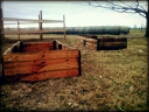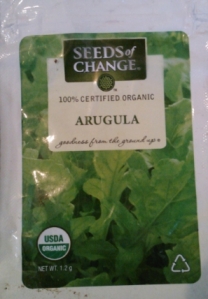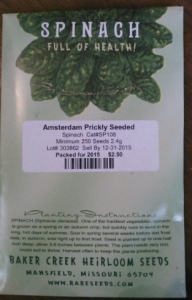Table of Contents (Quickly Jump To Information)
Get out the compost and make those raised beds, because spring is almost here.

I’m starting my tomato and squash seedlings indoors, and even starting some crops outside (potatoes, anyone?). Now, before you think I’m jumping the gun, here’s the thing about me.
I love kale, and I’m not afraid to say it.
Mix it with some homemade butter and straight-from-the-garden garlic, and I’m set. I start growing it as soon as I possibly can.
I can even get my husband to eat it on occasion.
Getting your garden started? Want to reap a better harvest?
YES, I WANT A GREAT HARVEST!
I’ve never been a big fan of radishes and arugula, but I’m starting them soon for the animals, with the hope it will even further reduce our grain expenditures.
I’m starting to get the winter blues, so focusing on spring is helping me beat them. And I’m increasing my self-sufficiency at the same time!
Here’s a starter guide to the crops you can grow in early spring, for both people and animals.
The most important thing I’m doing at this stage (aside from planting!) is using mulch to cover the garden. The last thing I want is late-winter scavengers to snap up the seeds I spent so much time planting!

For a continual supply, succession plant every 2 weeks until high temps will cause the arugula to bolt.
Beets – Sow seeds in early spring as soon as the soil can be worked. Plant in well-drained, sandy soil. Avoid high nitrogen fertilizers as this will encourage top growth at the expense of root development.
Aerate your soil for uniform, healthy development. Keep consistently moist. Mulch to suppress weeds.
Broccoli – Sow broccoli directly in the garden 4 weeks before your last frost date. You can set out transplants 2 weeks before the last frost date when day time temperatures are between 65 and 80 degrees.
Give your plants a boost 3 weeks after transplanting.
Cabbage – Sauerkraut anyone? Direct sow in the garden immediately after your last frost date, or plant transplants in the garden 2 weeks before your last front date.
Start seeds 6 to 8 weeks indoors before your last front date. Cabbage plants require soil rich in organic matter and consistent moisture.
Carrots – Plant seeds about 2 weeks before your last frost date. Carrots need deep, loose soil to form a strong, straight root. Keep the bed mulched to avoid competition from other plants.
Avoid forked roots by limiting nitrogen and keeping the bed stone-free. When the seedlings are about 2 inches tall, thin them so there’s 1″ to 4″ gaps between them.
You can also use alternate planting to increase your harvest and cut down on thinning. I use pre-planted seeds I created over winter to cut down on thinning.
Collards – Collard transplants can be planted 4 to 6 weeks before the last frost date in your area. Plant in fertile, well-drained soil. Soil rich in organic matter will encourage tender leaves, great for microgreens.

Kohlrabi – Put out transplants of this funky looking plant 4 weeks before your last frost date. Kohlrabi is related to the cabbage, and can be eaten in similar ways.
Mulch or use protection against severe temperatures, and the cool temps will enhance the flavor.
Lettuce – The ideal day time temps for lettuce are between 60 and 70 degrees. Lettuce is more sensitive to cold than other cool season vegetables, so be sure to cover during freezing temps.
Fertilize with a high-nitrogen fertilizer. Lettuce will grow in partial shade, and does better sheltered from the hot afternoon sun. Romaine is a favorite here (I finally steered my husband away from iceberg!)
Onions – Onions can be grown from sets, seeds, or transplants. This year I’m trying both sets and seeds.
Plant in early spring as soon as the soil is workable. Mulch to protect from hungry critters and freezing temperatures.
Peas – Direct sow in the garden 4 to 6 weeks before the last frost date in your area. They will germinate in soil temperatures as low as 40 degrees F.
Seedlings will survive a late snow and short periods of temperatures down to 25* F.
Potatoes – Plant potatoes when temps rise (if you want a permaculture indicator, plant your seed potatoes when grass begins to grow).
I cut my potatoes into 1” pieces with 2 to 3 eyes, you can also plant the whole potato. Soil should be loose, fertile and well drained. Mulch to protect from hungry critters and freezing temperatures.
Radishes – This year, I’m doing daikon, french breakfast, and regular radishes. Sow radish seeds in the garden about 4 weeks before the last frost date in your area.
They are ready to harvest as soon as they are of edible size. Succession plant for a continual supply until temps are too high. Try one more than one variety, and see which does best in your garden.

Transplants can be set out 4 weeks before the last frost date in your area. Spinach prefers very fertile soil, so plant in soil enriched with compost, or fertilize when the plants are about 4 inches tall.
Swiss Chard – There’s nothing better than the gorgeous colors swiss chard brings to your garden. Direct sow seeds 2 weeks before your last frost date.
Use pre-made seed tapes, or thin to 6-inches apart when seedlings are 3-inches tall. Water regularly and mulch to protect.
Tatsoi – Extremely cold hardy, tatsoi can withstand temperatures down to -15 degrees F. Tatsoi likes rich soil and plenty of moisture all through the growing season, so mulching is best.
It’s a very pretty ornamental, so consider growing it in your landscape. Space the initial planting very densely, then harvest entire plants for baby greens, but leave the final survivors to grow to maturity at about 12″ spacing.
Turnips – Plant 2 weeks before the last frost date. Any well-drained soil will do.
Consistent moisture is key for healthy root development. Although it is not necessary, the greens will be the most tender if you plant in a fertile soil.
Wheat – We’re going to try wheat for the first time this spring. Be sure to use a spring variety (winter wheat won’t produce without some hard freezes) so check that label.
Plant when the ground can be worked and after your last frost date. It’s best to use a seed drill, but if you can’t, you can broadcast the seeds and rake them into the ground, making sure to cover with hay or mulch to keep critters away.
I’d like to hear from you!
Which of these cold weather crops will you plant? Leave a comment below!
Maat van Uitert is a backyard chicken and sustainable living expert. She is also the author of Chickens: Naturally Raising A Sustainable Flock, which was a best seller in it’s Amazon category. Maat has been featured on NBC, CBS, AOL Finance, Community Chickens, the Huffington Post, Chickens magazine, Backyard Poultry, and Countryside Magazine. She lives on her farm in Southeast Missouri with her husband, two children, and about a million chickens and ducks. You can follow Maat on Facebook here and Instagram here.






![Substitute Honey For Sugar & Get Perfect Baked Goods [Conversion Chart]](https://thefrugalchicken.com/wp-content/uploads/2017/06/Can-I-substitute-honey-for-sugar-feature.jpg)

![Get 101 Recipes For Homemade Products In A Single Valuable Resource [Product Review]](https://thefrugalchicken.com/wp-content/uploads/2016/05/101-Easy-Homemade-Products-For-Your-Skin-Health-Home-cover-feature.jpg)

This is getting me so excited for my garden!! This year my goal is to try and add more root vegetables that can be stored and eaten throughout the year. I live in VT so I want to be able to grow as much as possible and reap the rewards during the off season. Thanks for sharing, this post is amazing!!!
Thank you for your kind words. I grew up in MA on the VT border – root veggies are a great way to go up there since winter is long and cold!
I have so many things on my “to plant” list but I need to make more beds for everything or get the roto tiller working to work the soil for some rows.
Great information, and love that you went in depth with each veggie…thank you!! Last year was my “experiment” garden…in a new home so I wasn’t sure about sun exposure, and I really hadn’t gardened since I was a kid helping out in my dad’s garden. But it went well and I’m excited to have a “real” garden this year, and all of your info is going to be a big help! I’m looking forward to following your blog/site.
Great reminders and love the info about each plant. I live in BC Canada planting in October- garlic, broccoli, kale, cabbage, cooking onions, peas, carrots, radishes and Mix of lettuce.
The items I planted in large pots did fantastic I have my first broccoli head showing and have enjoyed the leaves throughout the winter. The seeds I planted in the ground were very slow to grow, for instance my peas grew about 2-3 inches and stayed that way until a few weeks ago. Today I noticed flower buds and new growth.
My radishes and lettuce I kept growing all winter by putting two tomato cages in the pot and put a large clear (leaf) bag over them tying the bag around the pot. A couple of my lettuce have gone to bloom which I will eat also.
There is a story about the cooking onions that is too long to go into but in order to save the bulbs I planted them thinking that before our frosts I would dig them out and save the new small bulb.. I didn’t have to as my friend is a gardener and she said just leave them, if the greens die back don’t worry they will come back in the spring and you will get an earlier crop. Well only a few died back and they are all doing well and have started new growth. I have never gotten my onions in the ground this early. What a treat!